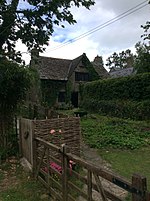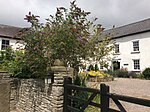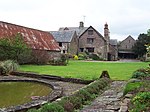Barn, Stable and Cider House, Great Tre-Rhew Farm, Llantilio Crossenny
Buildings and structures in MonmouthshireGrade II* listed buildings in Monmouthshire

The Corn Barn, Stable and Cider House at Great Tre-Rhew Farm, Llantilio Crossenny, Monmouthshire form part of "one of the most completely surviving farmsteads in the county". Constructed in the late 17th century, the corn barn is an eight-bay structure with the stable and cider house forming two, gabled, linked additions. The whole is a Grade II* listed structure. The other buildings that comprise the farmstead include the farmhouse, a granary and brewhouse, and a shelter shed, all of which have their own Grade II listings.
Excerpt from the Wikipedia article Barn, Stable and Cider House, Great Tre-Rhew Farm, Llantilio Crossenny (License: CC BY-SA 3.0, Authors, Images).Barn, Stable and Cider House, Great Tre-Rhew Farm, Llantilio Crossenny
Old Ross Road,
Geographical coordinates (GPS) Address Nearby Places Show on map
Geographical coordinates (GPS)
| Latitude | Longitude |
|---|---|
| N 51.8547 ° | E -2.905 ° |
Address
White Castle Vineyard Caravan Park
Old Ross Road
NP7 8PY , Skenfrith
Wales, United Kingdom
Open on Google Maps











